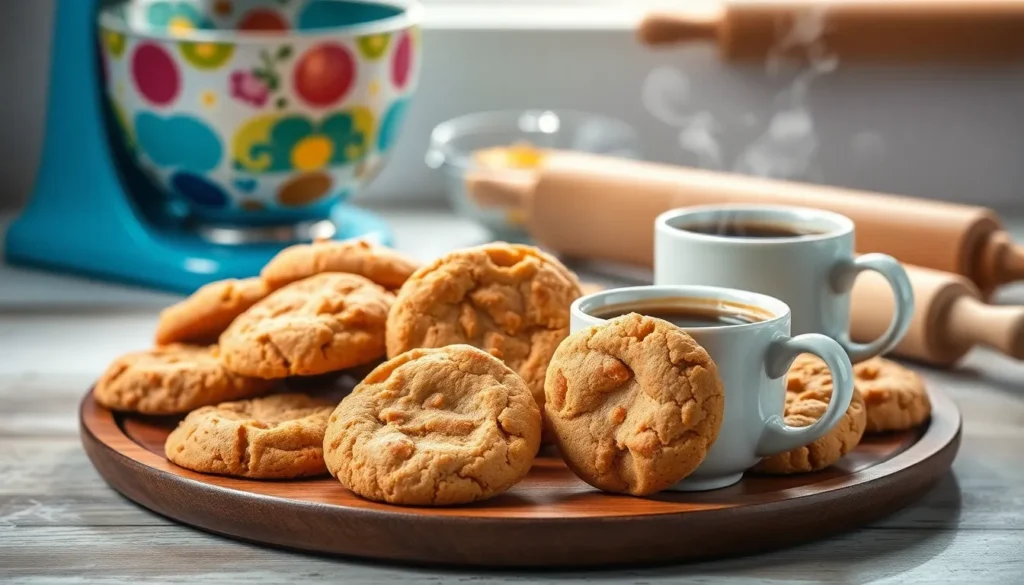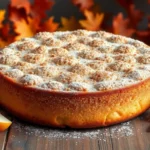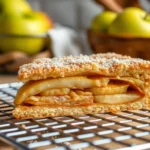We’ve all fallen under the spell of those perfectly spiced, caramelized cookies that come with our coffee at cafes worldwide. Biscoff cookies – those crispy Belgian treats with their distinctive cinnamon warmth and golden sweetness – have captured hearts across the globe since 1932.
What makes these cookies so irresistible? It’s the perfect balance of caramelized sugar and warm spices that creates that signature flavor we can’t get enough of. Originally created by the Lotus Bakery in Belgium, Biscoff cookies were designed to pair beautifully with coffee, but they’ve become a beloved snack all on their own.
Now we’re bringing that iconic taste right to your kitchen. Our homemade version captures all the buttery crispness and complex spiced flavor of the original, letting you enjoy fresh-baked Biscoff cookies whenever the craving strikes. Trust us – once you smell these baking, you’ll understand why they’ve become a worldwide obsession.
Ingredients
Creating our homemade Biscoff cookies requires simple pantry staples that combine to deliver that signature caramelized flavor. We’ve organized these ingredients into two categories to help you prepare everything needed for both the cookies and an optional finishing glaze.
For the Cookies
- 2 cups all-purpose flour
- 1 teaspoon baking soda
- 1 teaspoon ground cinnamon
- 1/2 teaspoon ground ginger
- 1/4 teaspoon ground nutmeg
- 1/4 teaspoon ground cloves
- 1/2 teaspoon salt
- 1/2 cup unsalted butter, softened to room temperature
- 1/2 cup packed light brown sugar
- 1/4 cup granulated sugar
- 1 large egg, at room temperature
- 2 tablespoons honey
- 1 tablespoon vanilla extract
- 2 tablespoons whole milk
For Optional Glaze
- 1 cup powdered sugar, sifted
- 3 tablespoons whole milk
- 1/2 teaspoon vanilla extract
- Pinch of ground cinnamon
Equipment Needed
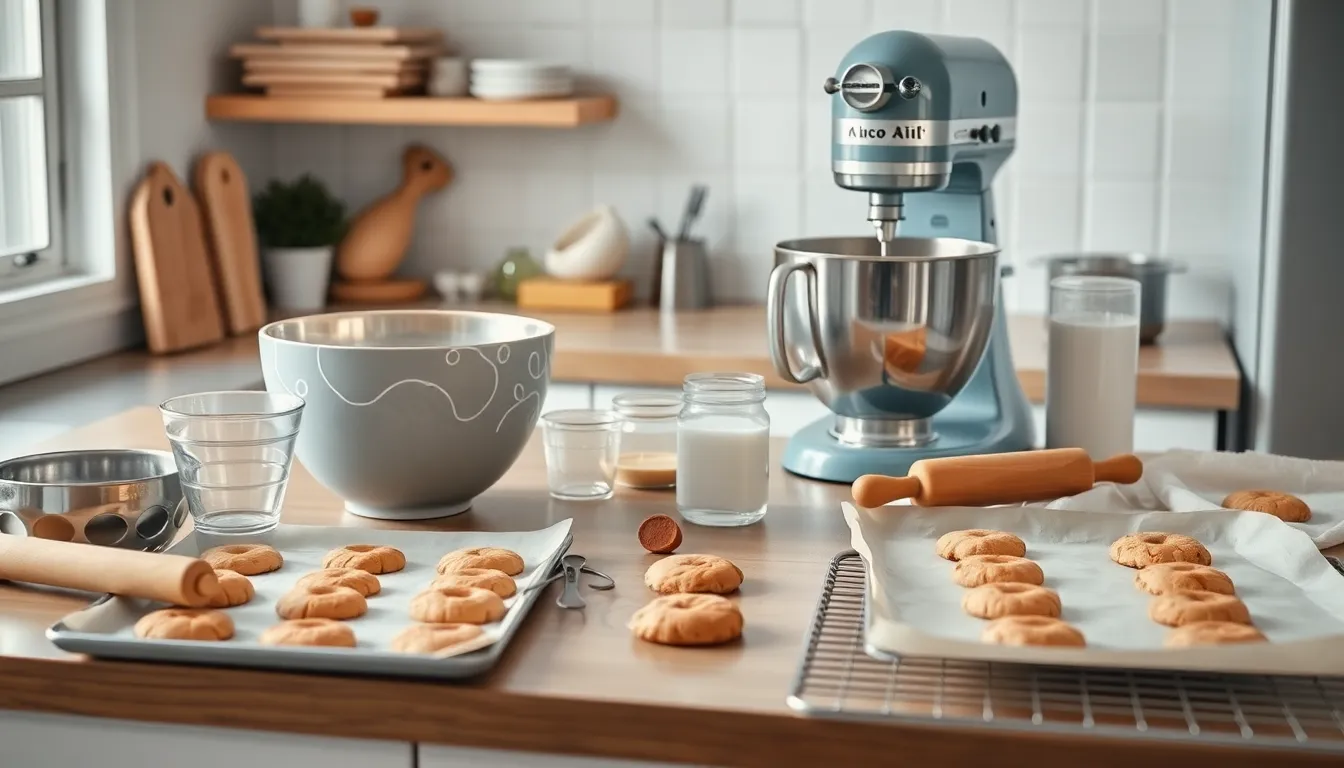
Creating our homemade Biscoff cookies requires standard kitchen equipment that most home bakers already have on hand. We’ll need a large mixing bowl for combining our dry ingredients and a separate bowl for creaming the butter and sugars together.
A stand mixer or hand mixer proves essential for achieving the proper texture when creaming butter with both brown and granulated sugars. Electric mixers ensure we incorporate enough air into the mixture to create that signature light yet dense texture found in authentic Biscoff cookies.
Rolling pins become crucial for achieving the thin, even thickness that gives these cookies their characteristic crispness. We recommend using a heavy rolling pin to apply consistent pressure across the dough surface.
Cookie cutters or a sharp knife allow us to shape our cookies into the traditional rectangular form. Professional Biscoff production uses specialized pressing and cutting machines that apply precise pressure, but we can achieve similar results with careful attention to uniform sizing.
Baking sheets lined with parchment paper prevent sticking and ensure even browning. We suggest using light colored aluminum sheets rather than dark ones to avoid over browning the cookie bottoms.
A wire cooling rack helps maintain the cookies’ crispiness by allowing air circulation around each piece. This cooling method prevents the trapped steam that could soften our carefully baked cookies.
Measuring cups and spoons ensure accuracy with our ingredient ratios. Digital kitchen scales provide even greater precision for consistent results batch after batch.
An instant read thermometer helps monitor our oven temperature, ensuring the controlled heat zones necessary for proper caramelization of the sugars that create Biscoff’s distinctive flavor profile.
Instructions
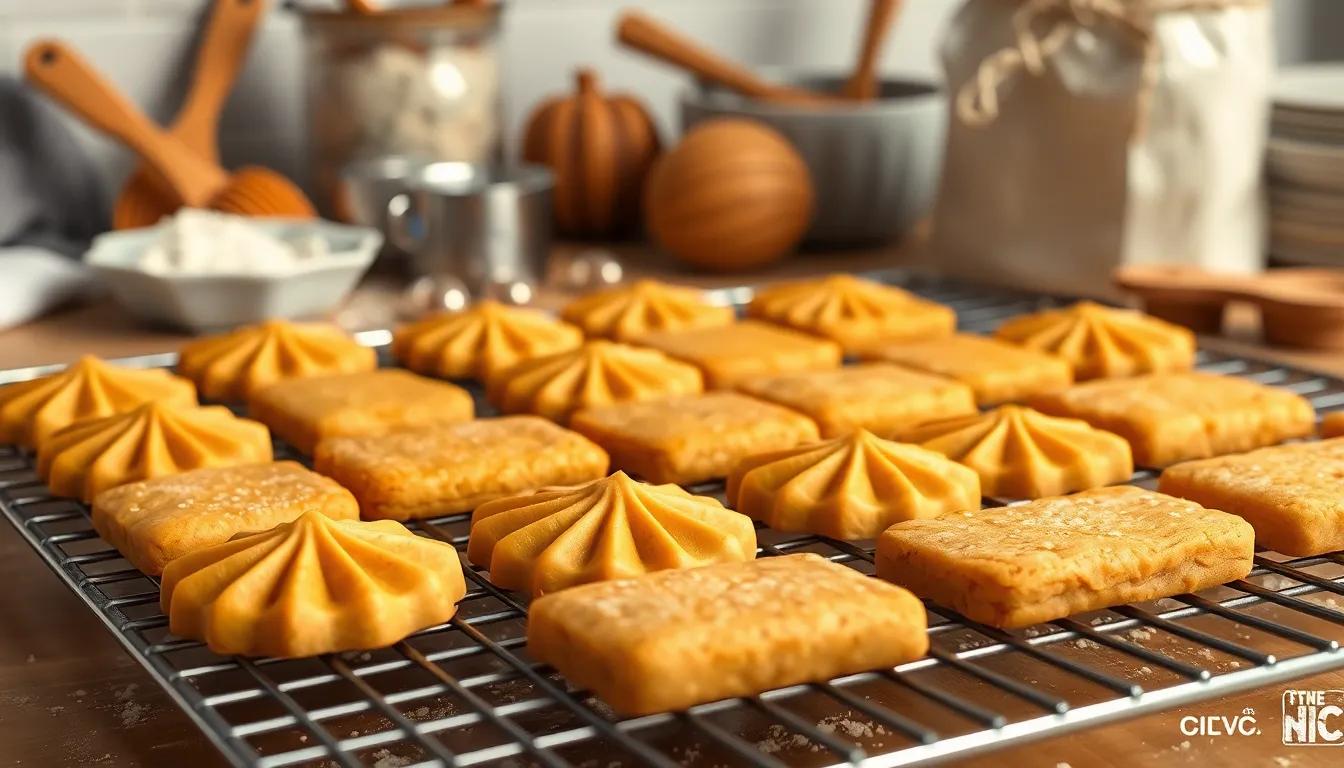
We’ll walk you through creating these delicious Biscoff cookies step by step. Our method ensures you achieve that signature crispy texture and warm spice flavor.
Prep the Dough
We begin by combining our dry ingredients in a separate bowl. Whisk together the all-purpose flour, baking soda, cinnamon, nutmeg, ginger, allspice, and cloves until evenly distributed.
Next, we cream the butter with both granulated and brown sugars using our stand mixer or hand mixer. Beat the mixture for 3-4 minutes until light and fluffy. We then add the egg, honey, and vanilla extract, mixing until well incorporated.
Gradually, we add our dry ingredient mixture to the butter mixture, alternating with the milk. Mix on low speed until the dough just comes together. We want to avoid overmixing at this stage.
Once our dough forms, we wrap it tightly in plastic wrap and chill for at least 1 hour. This chilling step firms up the dough and makes it easier to roll and cut.
Shape the Cookies
We remove our chilled dough from the refrigerator and let it sit for 5 minutes to soften slightly. On a lightly floured surface, we roll the dough to approximately ¼ inch thickness.
Using our fluted rectangle cookie cutters (about 2 x 3 inches), we cut out our cookies. We can also use a sharp knife to create rectangular shapes if we don’t have specialty cutters.
We place our cut cookies on parchment-lined baking sheets, spacing them about 1 inch apart. Any leftover dough can be re-rolled and cut again.
Bake the Cookies
We preheat our oven to 325°F (165°C) while we finish shaping our cookies. This moderate temperature ensures even browning without burning the spices.
We bake our cookies for 16-18 minutes until they turn golden brown around the edges. The centers should look set but not overly dark.
Our cookies are done when they feel firm to the touch and have developed that characteristic golden color. We avoid overbaking as this can make them too hard.
Cool and Finish
We let our cookies cool on the baking sheet for 5 minutes before transferring them to a wire cooling rack. This brief cooling period prevents them from breaking while still warm.
Once completely cooled, we can apply our optional glaze by whisking together powdered sugar, milk, vanilla extract, and a pinch of cinnamon. We drizzle this glaze over our cookies or dip each cookie halfway.
Our finished Biscoff cookies will stay fresh in an airtight container at room temperature for up to 10 days. We store them between layers of parchment paper to maintain their crispy texture.
Directions for Storage
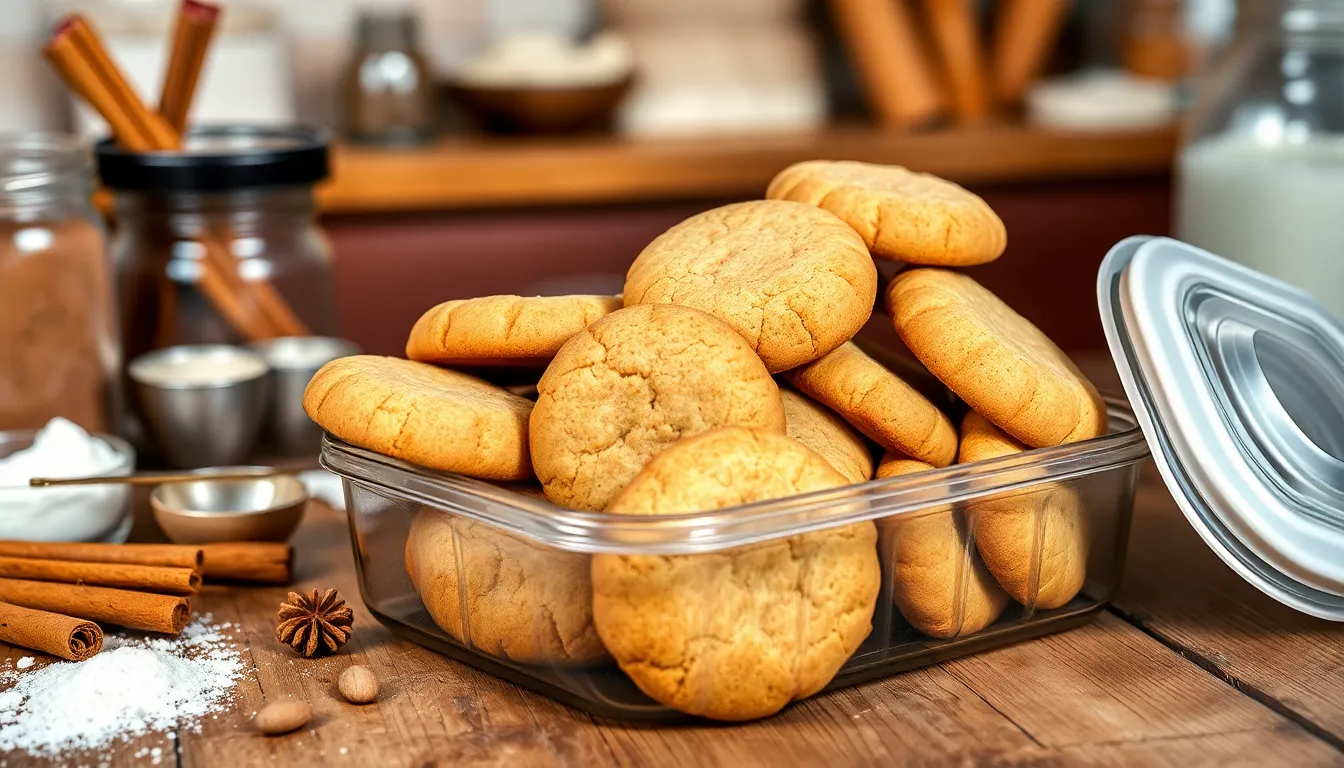
Proper Storage Environment
We recommend storing your homemade Biscoff cookies in a completely dry environment away from any heat sources. Room temperature provides the ideal conditions for maintaining their signature crispy texture and preserving their distinctive cinnamon flavor. Our cookies perform best when kept in spaces with consistent temperature and low humidity levels.
Container Selection and Duration
Store your finished cookies in an airtight container at room temperature for optimal freshness. These containers will keep your Biscoff cookies crisp and flavorful for up to 5 days when properly sealed. We suggest choosing containers that eliminate air exposure to prevent the cookies from becoming soft or stale.
Long Term Storage Options
Freezing extends the storage life of your homemade Biscoff cookies significantly. Place the completely cooled cookies in freezer-safe containers or bags for storage periods of 2 to 3 months. Label containers with the preparation date to track freshness and ensure you enjoy them at their peak quality.
Cookie Dough Storage
We can prepare cookie dough ahead of time for convenient future baking. Form the chilled dough into individual cookie balls and freeze them for up to 2 months. Allow the frozen dough balls to return to room temperature before rolling and cutting into shapes for baking.
Storage Comparison Table
| Storage Method | Duration | Temperature | Container Type |
|---|---|---|---|
| Room Temperature | Up to 5 days | Room temperature | Airtight container |
| Freezer (baked cookies) | 2-3 months | 0°F (-18°C) | Freezer-safe container |
| Freezer (cookie dough) | Up to 2 months | 0°F (-18°C) | Freezer-safe bag/container |
Make-Ahead Tips
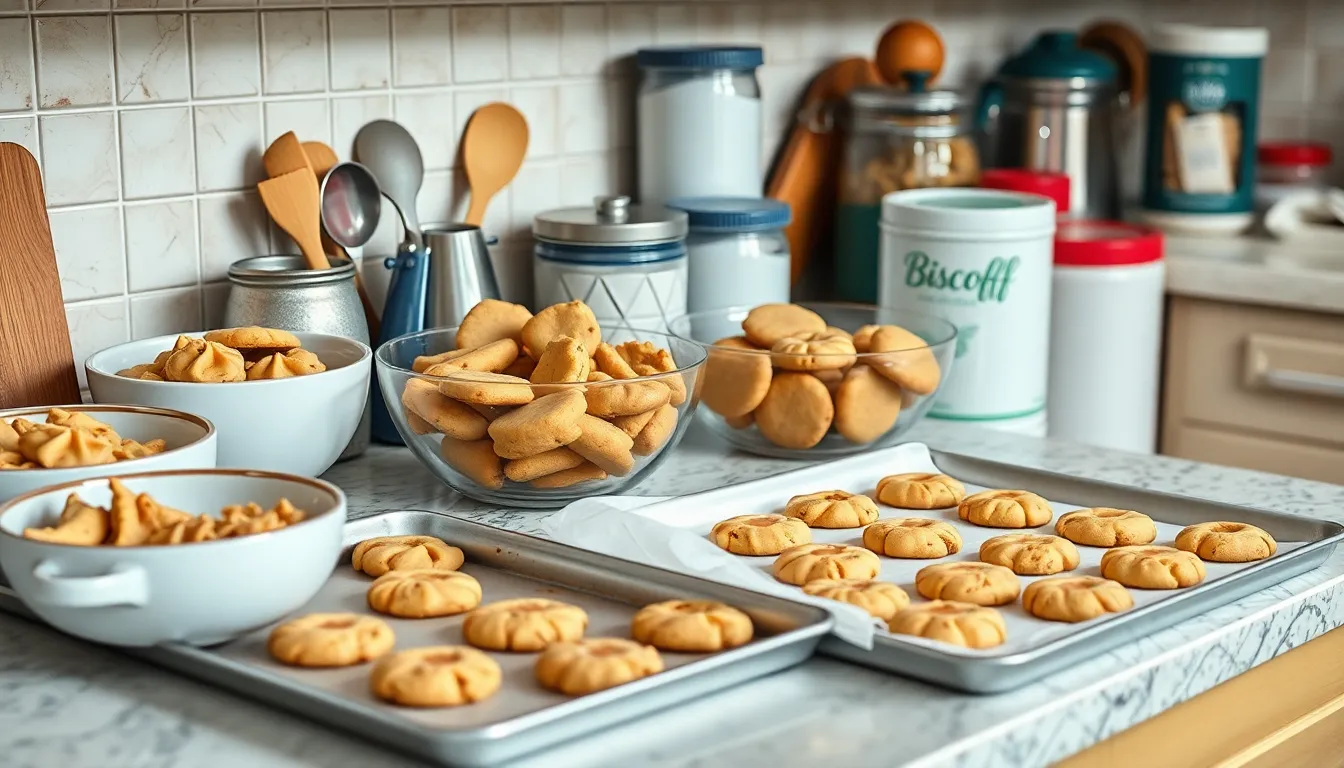
Planning ahead makes baking Biscoff cookies much more convenient for busy schedules. We recommend preparing the dough in advance to streamline your baking process and ensure fresh cookies whenever you want them.
Refrigerating Cookie Dough
Fresh cookie dough stores beautifully in the refrigerator for 1-2 days. We suggest wrapping the dough tightly in plastic wrap or placing it in an airtight container to prevent it from drying out. This short-term storage method works perfectly when you want to bake cookies within a few days of preparation.
Freezing for Extended Storage
Freezing offers the best option for long-term storage of both dough and finished cookies. Cookie dough balls freeze exceptionally well for up to 2 months when stored properly in freezer-safe containers or bags. We recommend portioning the dough into individual cookie-sized balls before freezing to make baking more convenient later.
Baked cookies also freeze successfully for 2-3 months when wrapped carefully and stored in airtight containers. This method allows you to bake large batches and save portions for future enjoyment.
Optimal Timing Strategy
| Storage Method | Duration | Best Use |
|---|---|---|
| Refrigerated dough | 1-2 days | Weekend baking prep |
| Frozen dough balls | Up to 2 months | Batch preparation |
| Frozen baked cookies | 2-3 months | Long-term storage |
Baking directly from frozen dough requires no thawing time. Simply add 1-2 extra minutes to the original baking time and watch for the golden brown color that indicates doneness. This flexibility means you can have fresh Biscoff cookies ready in under 20 minutes whenever the craving strikes.
Serving Suggestions
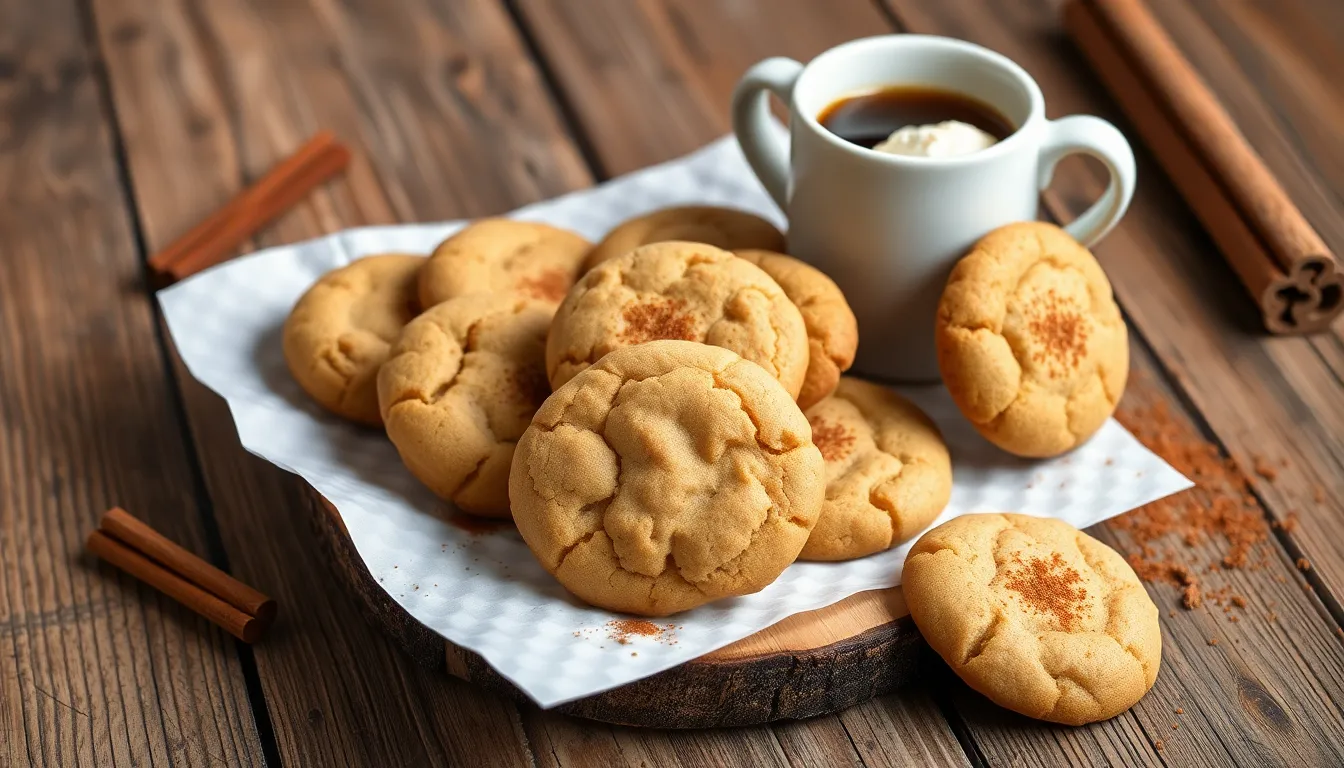
Our homemade Biscoff cookies shine brightest when paired with complementary flavors and textures that enhance their distinctive caramelized spice profile. These versatile treats transform from simple cookies into elegant dessert components with the right accompaniments.
Whipped cream or vanilla ice cream creates the perfect contrast to our cookies’ crispy texture. The creamy richness balances the warm spices while allowing the caramelized sugar notes to stand out. We recommend serving two cookies alongside a generous scoop of vanilla ice cream for an indulgent treat.
Coffee and tea pairings showcase why Biscoff cookies became a café staple worldwide. Their spiced flavor profile complements both bold espresso and delicate teas. We suggest dunking the cookies briefly in hot coffee to soften the edges while maintaining that signature crunch.
Oat milk hot chocolate receives an instant upgrade when we add a Biscoff cookie as both stirrer and flavor enhancer. The cookie slowly releases its caramelized notes into the warm beverage while providing textural interest with each sip.
Our cookies also excel in layered desserts where their flavor can infuse other components. Crush them into crumbs for cheesecake bases or layer whole cookies in trifles between vanilla pudding and fresh whipped cream. The possibilities multiply when we consider tiramisu variations that substitute our Biscoff cookies for traditional ladyfingers.
Brown sugar and vanilla elements in accompanying desserts amplify the cookies’ inherent sweetness. White chocolate drizzles or dips create beautiful presentations while balancing the spiced intensity. Warm spices like cinnamon and nutmeg in accompanying elements create harmonious flavor profiles that celebrate the cookies’ Belgian heritage.
Fresh fruit serves as an unexpected but delightful pairing option. Sliced pears or apples provide crisp contrast while stone fruits like peaches complement the caramelized notes during summer months.
Recipe Variations

Building on our classic Biscoff cookie recipe, these creative variations offer exciting ways to enjoy the beloved cinnamon spiced flavor. Each adaptation maintains the signature taste while introducing complementary elements that enhance the overall experience.
Chocolate Chip Biscoff Cookies
We love combining rich chocolate with the distinctive taste of Biscoff in these irresistible cookies. The recipe starts with our base ingredients but incorporates additional elements that create soft centers with crisp edges loaded with melty chocolate and satisfying Biscoff crunch.
For these enhanced cookies, we add cookie butter to the creaming process alongside unsalted butter. This doubles the Biscoff flavor while creating an incredibly tender texture. Semi-sweet chocolate chips provide bursts of richness throughout each bite, while crushed Biscoff cookies add textural contrast and intensify the signature spiced flavor.
The preparation follows our standard method with one key difference: we fold in chopped semi-sweet chocolate and crushed Biscoff cookies during the final mixing stage. This ensures even distribution without overmixing the dough. The result delivers cookies that are soft and chewy in the center with delightfully crisp edges.
Biscoff Sandwich Cookies
These elegant sandwich cookies transform our basic recipe into an impressive dessert perfect for special occasions. We create these by pairing two of our homemade Biscoff cookies with a luscious filling that amplifies the original flavor profile.
The filling combines softened butter with Biscoff cookie butter, creating a smooth and spreadable mixture. We add powdered sugar for sweetness and a touch of vanilla extract to enhance the overall flavor complexity. For extra texture, we fold in finely crushed Biscoff cookies that provide delightful crunch in every bite.
Assembly requires completely cooled cookies to prevent the filling from melting. We spread approximately one tablespoon of filling on the flat side of one cookie, then gently press a second cookie on top. The sandwich cookies can be served immediately or chilled for 30 minutes to firm up the filling before serving.
| Variation | Additional Ingredients | Texture | Flavor Profile |
|---|---|---|---|
| Chocolate Chip | Semi-sweet chocolate chips, cookie butter, crushed Biscoff | Soft center, crisp edges | Rich chocolate with spiced cookie |
| Sandwich | Cookie butter filling, powdered sugar, vanilla | Tender with creamy filling | Intensified Biscoff flavor |
Troubleshooting Tips
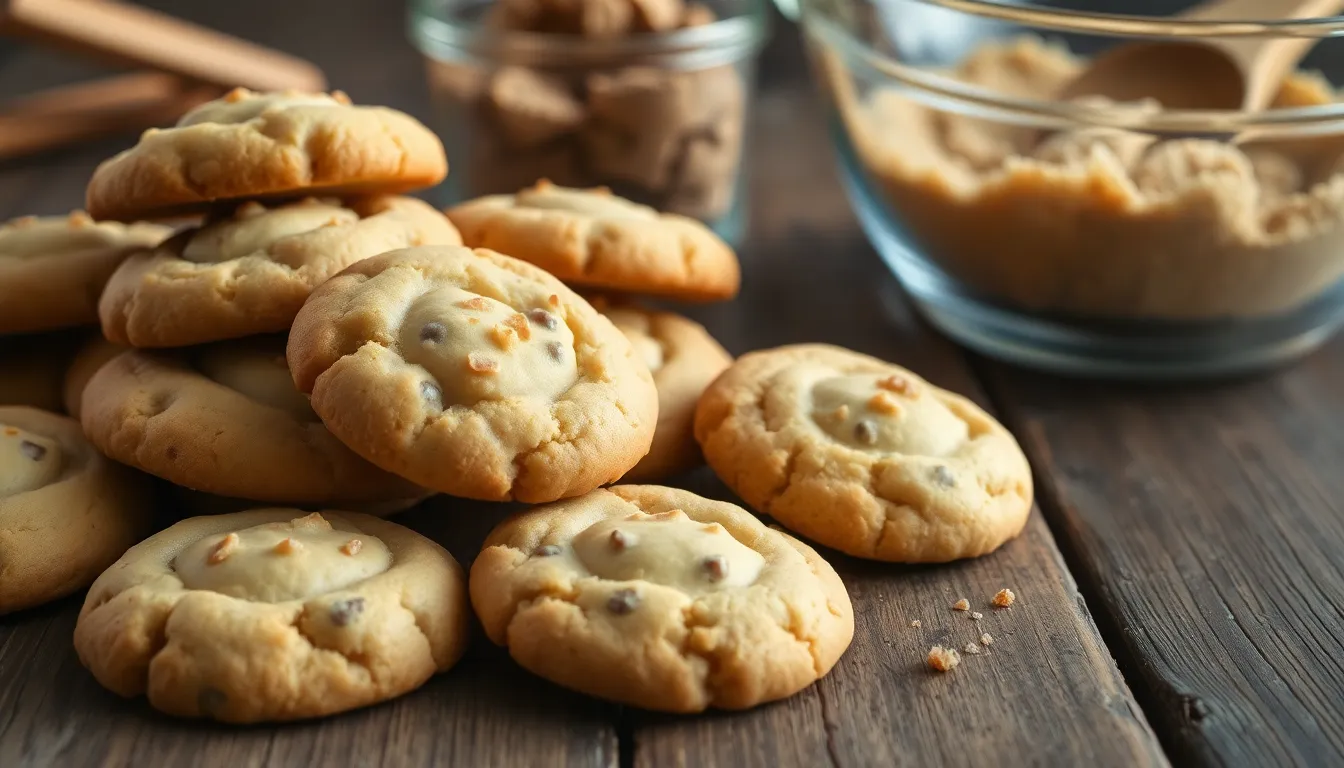
Even experienced bakers encounter challenges when perfecting their Biscoff cookies. We’ve compiled answers to the most common issues that can affect your cookies’ texture and appearance.
Cookie Spreading Problems
Excessive spreading ranks as the most frequent issue we encounter with Biscoff cookies. When your cookies spread too much during baking they lose their intended shape and become thin. We recommend chilling your cookie dough balls for at least two hours before baking. For optimal results freeze the dough overnight to ensure cookies maintain their form during the baking process.
Texture Issues
Hard cookies instead of the desired chewy texture typically result from overbaking. We suggest removing cookies from the oven when edges turn golden brown even if centers appear slightly soft. The cookies will continue firming up as they cool on the baking sheet. This technique prevents the dry crumbly texture that ruins the Biscoff experience.
Dough Consistency Problems
Dry cookie dough creates difficulties during rolling and shaping. Cold butter often causes this issue along with insufficient wet ingredients. We ensure all eggs reach room temperature before mixing and add one tablespoon of milk or an extra egg yolk when the dough feels too dry. Room temperature ingredients blend more effectively creating smoother dough.
Uneven Baking Results
Inconsistent cookie results across your baking sheet indicate temperature or preparation issues. We address this by preheating the oven properly and using lined baking trays for even heat distribution. Cookie dough balls should measure consistently for uniform baking. An oven thermometer helps verify accurate temperature since many ovens run hot or cold.
| Baking Issue | Temperature Check | Solution |
|---|---|---|
| Uneven browning | Use oven thermometer | Verify 350°F (180°C) accuracy |
| Some cookies burn | Rotate pans | Switch positions halfway through |
| Slow baking | Check heating elements | Clean oven for proper heat circulation |
Biscoff Filling Challenges
Filled Biscoff cookies present unique challenges when the filling leaks during baking. Insufficiently frozen Biscoff dollops cause this messy problem. We freeze the Biscoff portions until completely firm before wrapping them in cookie dough. Complete sealing around the filling prevents leakage and maintains the cookie’s structure.
Butter Preparation Guidelines
Properly softened butter creates the foundation for successful Biscoff cookies. The butter should make an indent when pressed but not squish easily under light pressure. We cream butter and sugars thoroughly before incorporating dry ingredients. This process typically takes 3-4 minutes with an electric mixer and creates the light fluffy texture essential for proper cookie development.
Optimal Baking Parameters
Temperature precision affects every aspect of cookie quality. We bake our Biscoff cookies at 350°F (180°C) for 16-18 minutes rotating pans if necessary for even browning. Parchment paper prevents sticking while promoting consistent bottom browning. These parameters ensure cookies achieve the perfect balance of crispy edges and tender centers that define authentic Biscoff cookies.
Conclusion
We’ve shared everything you need to master the art of homemade Biscoff cookies right in your own kitchen. From the essential ingredients and step-by-step instructions to creative variations and troubleshooting tips our comprehensive guide ensures you’ll achieve that perfect crispy texture and warm cinnamon flavor every time.
Whether you’re making classic cookies chocolate chip variations or elegant sandwich cookies these recipes offer endless possibilities for enjoying this beloved Belgian treat. With proper storage techniques and make-ahead options you can always have fresh Biscoff cookies ready for any occasion.
Now it’s time to roll up your sleeves grab your mixing bowl and start baking. Your kitchen will soon be filled with the irresistible aroma of homemade Biscoff cookies that rival the original.
Frequently Asked Questions
What are Biscoff cookies and where do they come from?
Biscoff cookies are beloved Belgian treats created by Lotus Bakery in 1932. They’re known for their distinctive crispy texture and warm cinnamon flavor. Originally designed to complement coffee, these spiced cookies have become popular as standalone snacks worldwide due to their unique buttery crispness and aromatic spice blend.
What ingredients do I need to make homemade Biscoff cookies?
You’ll need simple pantry staples: all-purpose flour, baking soda, cinnamon, nutmeg, ginger, cloves, butter, brown sugar, white sugar, one egg, honey, vanilla extract, and milk. For an optional glaze, gather powdered sugar, milk, vanilla extract, and a pinch of cinnamon to enhance the cookies’ flavor.
How long should I chill the Biscoff cookie dough?
Chill the dough for at least one hour before rolling and cutting. This firming step is essential for preventing excessive spreading during baking and achieving the proper crispy texture. The chilled dough will be easier to handle and maintain its shape when cut into cookies.
What temperature and time should I use for baking Biscoff cookies?
Bake the cookies at 325°F (165°C) for 16-18 minutes until they turn golden brown. This moderate temperature ensures even baking and prevents the cookies from burning while achieving the signature crispy texture. Remove them when the edges are set and lightly golden.
How should I store homemade Biscoff cookies to maintain freshness?
Store baked cookies in an airtight container at room temperature for up to 10 days. Keep them in a dry environment to maintain their crispy texture. For longer storage, freeze baked cookies for 2-3 months or freeze the cookie dough for up to 2 months.
Can I make Biscoff cookie dough ahead of time?
Yes! Cookie dough can be refrigerated for 1-2 days when tightly wrapped. For longer storage, freeze shaped dough balls for up to 2 months. You can bake directly from frozen – just add 1-2 extra minutes to the baking time for fresh cookies anytime.
What are some creative variations of Biscoff cookies?
Try Chocolate Chip Biscoff Cookies by adding cookie butter and semi-sweet chocolate chips for a rich twist. Another option is Biscoff Sandwich Cookies, where two homemade cookies are paired with a creamy filling made from Biscoff cookie butter, powdered sugar, and vanilla extract.
Why do my Biscoff cookies spread too much during baking?
Excessive spreading usually occurs when the dough isn’t chilled enough or the oven temperature is too high. Ensure you chill the dough for at least one hour and maintain the correct baking temperature of 325°F. Also, check that your butter wasn’t too warm when mixing the dough.
What beverages pair best with Biscoff cookies?
Coffee and tea are classic pairings that complement the cookies’ warm spices perfectly. The crispy texture makes them ideal for dunking in hot beverages. The cinnamon and spice notes in Biscoff cookies naturally enhance the flavors of both coffee and various tea blends.
How can I use Biscoff cookies in other desserts?
Biscoff cookies work wonderfully as cheesecake bases, in trifles, or layered desserts. They pair beautifully with whipped cream, vanilla ice cream, or fresh fruit. Their crispy texture and warm spices make them versatile components that add both flavor and crunch to various dessert creations.

